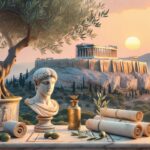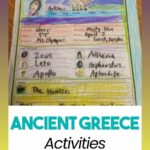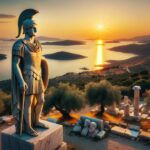Theseus, the legendary Athenian hero, didn’t just slay the Minotaur; he forged a nation. By uniting the twelve independent city-states of Attica, he laid the groundwork for Athenian democracy and left an enduring legacy of leadership and unity. This article explores the life and accomplishments of Theseus, delving into the myths and historical context surrounding his unification of Attica and his rise to prominence.
The Rise of a Unified Attica
Before Theseus, Attica resembled a fragmented puzzle. Twelve independent communities, each with its own governance and priorities, frequently clashed, leaving the region vulnerable. Theseus, recognizing the strength in unity, embarked on a mission to consolidate these disparate entities. While the exact methods he employed—persuasion, strategic alliances, or displays of force—remain a subject of scholarly debate, the outcome is undeniable: Theseus brought Attica under a single government based in Athens. This unification wasn’t merely a political maneuver; it fostered a shared Athenian identity and strengthened the region against external threats, paving the way for Athens’s future as a cultural and intellectual powerhouse. It suggests that without Theseus’s unifying influence, the trajectory of Athenian history might have been drastically different.
At one point in our lives, we have felt injustice because of someone else’s wrongdoing that we didn’t do, which calls for speaking up. If you are one of those, know that you are not alone. Read hombres necios que acusais to fully understand the concept of injustice.
The Significance of Synoikismos
The unification of Attica, known as synoikismos (meaning “dwelling together”), was a pivotal moment in ancient Greek history. It transformed Attica from a collection of feuding communities into a cohesive political entity.
| Feature | Before Theseus | After Theseus |
|---|---|---|
| Governance | 12 independent communities | Unified government in Athens |
| Inter-community relations | Frequent conflict | Cooperation and shared identity |
| Security | Vulnerable to threats | Stronger, more defensible |
| Identity | Fragmented | Unified Athenian identity |
| Future | Uncertain | Foundation for Athenian power |
While the precise details of the synoikismos might be obscured by myth and the passage of time, its impact is undeniable. Some scholars argue that the process may have been more gradual, unfolding over generations, with Theseus playing a crucial, albeit possibly exaggerated, role. Archaeological evidence may eventually reveal a more complete picture, but the narrative of Theseus uniting Attica remains a powerful testament to the transformative potential of leadership.
The Land United by Theseus: Attica
What was the land united by Theseus? – land united by theseus Attica, the region unified by Theseus, encompassed not only the city of Athens but also the surrounding towns and villages. Prior to unification, these twelve independent city-states operated autonomously, leading to frequent conflicts and hindering regional development. Theseus, recognizing this inherent weakness, likely used a combination of diplomacy, negotiation, and possibly force to persuade these communities to join forces under Athenian leadership.
The synoikismos was a game-changer. This act of unification transformed Attica into a powerful and cohesive force, laying the groundwork for its future prosperity and the rise of Athens as a cultural and political center.
| Feature | Before Synoikismos | After Synoikismos |
|---|---|---|
| Political Structure | 12 independent city-states | Unified political entity under Athens |
| Stability | Frequent conflicts and instability | Increased stability and security |
| Defense | Vulnerable to external threats | Stronger defense against external threats |
| Economic Growth | Limited by inter-city-state competition | Greater potential for economic development |
It’s important to acknowledge that much of what we know about Theseus comes from myths and legends. While historians believe the synoikismos likely occurred, the exact details remain subject to ongoing research and scholarly debate.
Decoding the Myth of Theseus
What was the myth of Theseus? – land united by theseus The myth of Theseus is a captivating narrative interwoven with heroism, political strategy, and monstrous encounters. Theseus’s legendary exploits, such as his confrontation with the Minotaur, solidified his status as a champion of the people. However, his most significant contribution was arguably the synoikismos. This political unification of Attica transformed Athens from a collection of scattered settlements into a major power, fostering a golden age of culture and philosophy.
While Theseus’s story is steeped in mythology, some scholars suggest it reflects real political and social changes occurring in Attica. Separating fact from fiction remains a challenge, but the myth offers valuable insights into the origins and aspirations of Athenian identity. The story’s enduring appeal lies in its exploration of courage, determination, and the potential for individual action to shape history. Ongoing research and interpretations continue to enrich our understanding of this iconic figure.
| Feature | Description |
|---|---|
| Hero | Theseus, a legendary Athenian hero known for his daring adventures and political leadership. |
| Monster Slayer | Famed for defeating the Minotaur, a monstrous creature with the head of a bull and the body of a man, in a labyrinth on the island of Crete. |
| Political Leader | Credited with the synoikismos, the unification of the scattered communities of Attica under the rule of Athens, a pivotal moment in Athenian history. |
| Legacy | Remembered as a symbol of courage, unity, and the transformative power of leadership. His story continues to inspire and intrigue us to this day. |
Theseus’s Monstrous Encounters
What monsters did Theseus fight? – land united by theseus Theseus’s journey to heroism was fraught with perilous encounters against a range of monstrous adversaries. His triumphs over these creatures not only demonstrated his bravery and cunning but also symbolized his ability to overcome adversity and protect his people. From human bandits like Periphetes the Club-Bearer and Procrustes the Stretcher to monstrous beasts like the Crommyonian Sow and the fire-breathing Marathonian Bull, Theseus consistently demonstrated his resourcefulness and strategic thinking.
His most famous adversary, the Minotaur, represented a terrifying threat to Athens. Theseus’s victory within the Labyrinth, aided by Ariadne’s thread, cemented his heroic status and further empowered him to unite Attica. While the monsters Theseus faced are often interpreted literally, they may also symbolize the dangers and uncertainties of life, or perhaps even human flaws that Theseus, through his struggles, sought to conquer. Ongoing research continues to shed light on the interpretation and significance of these monstrous encounters.
Theseus’s story remains a powerful example of the transformative power of leadership and the importance of unity. His legacy continues to inspire, reminding us that even amidst division and seemingly insurmountable challenges, a shared vision for a better future can be achieved through courage, determination, and a commitment to the common good.
- Unveiling the Enigma: Mansoureh Khojasteh Bagherzadeh’s Public Appearances & Private Life in Iran - July 18, 2025
- Unveiling the Mystery: Mansoureh Khojasteh Bagherzadeh’s Husband: A Rare Glimpse into a Private Life - July 18, 2025
- Unveiling Masoud Khamenei’s Mother: Power, Influence, and Iran’s Future - July 18, 2025

















1 thought on “Theseus and the Forging of Attica: Uniting a Land, Building a Legacy”
Comments are closed.